¿Por Qué Puerto Rico?
This story originally appeared in the February 2020 issue of Adventure Cyclist magazine.
Near the end of our fifth day touring around Puerto Rico, we all knew there would be a steep 600-foot climb. What I hadn’t planned for during my group’s map meeting the night before was the thrill of the 600-foot descent.
We rode 41 miles that hot December day along the eastern coast from Fajardo in the north corner, where we had a layover day to see the magnificent El Yunque rain forest, to Maunabo in the south. We had coastal views and sunny weather. We passed huge cliffs before we reached our oceanfront hotel in Maunabo, which felt more like the luxurious Mediterranean than tropical Caribbean. I half expected to see flashy cars and celebrities. Instead I saw brightly colored homes, pickup trucks, children playing, red flor de maga blooms along the green hills, palm trees, and black-and-white cows that stared at you up close.
It was my first experience with bike travel, and as gorgeous as my surroundings were, I felt like an utter failure. Clearly I hadn’t climbed enough hills while training. I had to walk most of the way uphill, and my panniers felt heavy. And I was feeling heavy too, with 40 extra pounds I had gained in the last five years. Why am I doing this? I thought as I pushed my steel bike with all my luggage on it. What was I thinking? Is this supposed to be fun?
My best friend, Saara Snow, who works as the Advocacy Manager at Adventure Cycling and invited me on this trip, patiently waited for me ahead. I told her I was weary so she took one of my two panniers to lighten my load for a bit.
When we got to the peak, I wiped away sweat and caught my breath. Saara handed me my pannier and said she’d meet me at the bottom, then pedaled away. The horizon made me feel small, and I thought about how easily I could get hit by a car if I wasn’t careful. My bike lights were all on. I looked at the horizon again, the ocean stretching out as far as the eye could see, and I saw Saara zoom downhill along the switchbacks. So I followed.
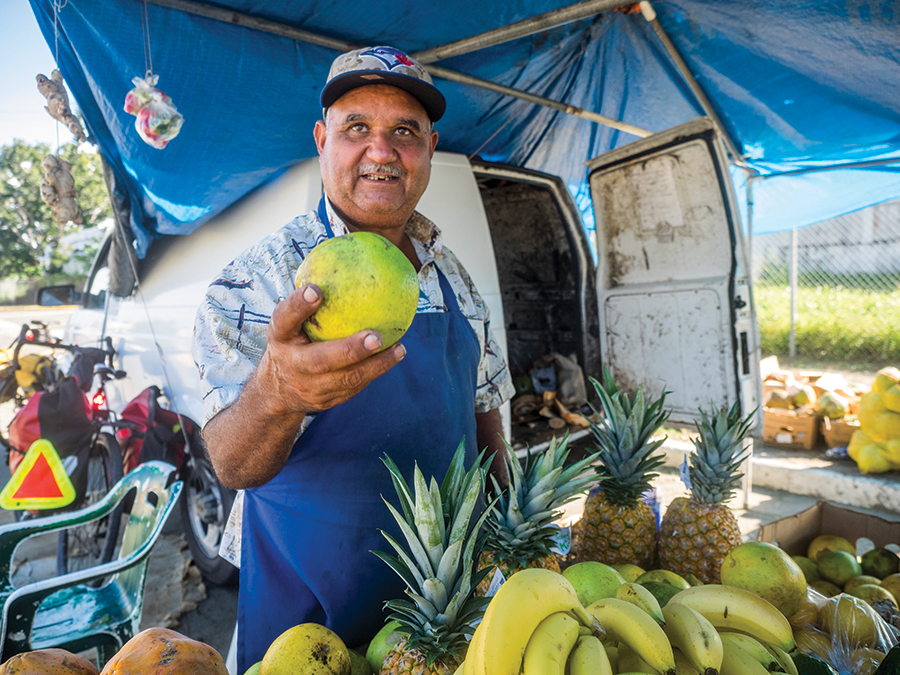
After feeling hot after working hard to make it uphill, nothing beats having cool wind in your face when racing downhill on your bicycle. I get terrible motion sickness from cars and turbulent airplanes, but never from cycling. I cheered “WOOOO HOOOOO!” as my bike sped up. I felt badass wearing the black cycling gloves I’d borrowed from Saara, and my cheeks were pink from wind.
That feeling grew when we arrived at our hotel on the beach. We rode up to the outdoor front desk where the employees were all impressed by our arrival and mistook me, a Thai-Italian American, as a Puerto Rican. Our Adventure Cycling tour group included our Puerto Rican New Yorker group leader Louis, a retiree couple, a middle-aged couple, a male scientist, and Saara and me. Everyone was over 50 except us. “That’s because we’re the only ones who have time and money,” the retired woman said on our first day.
I had neither, but I was determined to go on the trip. When Saara invited me, I was delighted, albeit scared, because I’ve never been athletic in my life. I had turned 30 six months before heading to Puerto Rico, and I had spent the last few years taking care of my young son and healing from ovarian cancer, endometriosis, postpartum thyroiditis, pregnancy, and an emergency C-section, not to mention balancing a stressful journalism career. A trip away from the daily grind was much needed. Plus I’m a “free spirit,” and while I love my family, I longed to travel and I missed Saara. I picked the 12-day inn-to-inn December 2018 tour in Puerto Rico, a place I had never been but had read about in the news following the devastation of Hurricane Maria in 2017. They’d appreciate our tourist dollars, plus it would be great to leave the continent for someplace warm during a rainy winter in northern California, where I live.
One major challenge as a woman under five feet tall was finding a bike. I went to at least five different bike shops in the San Francisco Bay Area, and none had a touring bike to fit my short legs. Six months before our trip, I explained my dilemma in a small local bike shop. The clerk took some measurements and suggested the Marin Four Corners, which comes in an extra-small size that is smaller than other brands’ extra-smalls. And at just over $1,000, it was within my price range. I wasn’t able to try it out though; the store had to special order it. But the clerk assured me I could return it right away if it didn’t fit. I showed up at the store a week later and there it was, its shiny bright blue paint glistening. It was love at first sight. I took it for a spin up and down the street. It felt perfect, and I knew it was the one. A 30th birthday present to myself.
Adventure awaited.
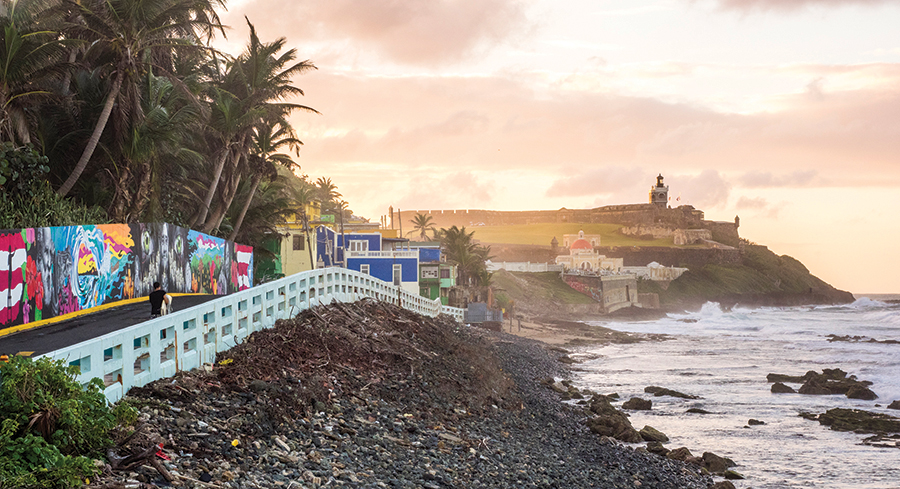
Day Six was our longest ride at 59 miles from Maunabo to Ponce, an artsy city in southern Puerto Rico. We pedaled a faster pace that morning. By mile 40, I was feeling tired and a little grouchy from the hot sun. It felt daunting that we still had nearly 20 miles to go after what felt like a full day of bicycling. That day was a blur as we went through neighborhoods, town plazas, a few hills, and coastal streets.
“I have to stop,” I growled at Saara, who is physically fit but ever patient with my slowness.
I took deep breaths and gazed out at the road. The sun was unrelenting. I looked down and closed my eyes. For a moment, I wanted nothing more than to stay there or hitchhike the rest of the way to Ponce. Although I had trained — I commuted to work 10 miles a day and did longer-distance rides on the weekends when I could — I had never gone much farther than 40 miles. Maybe my body couldn’t handle it, I thought. I’m short and fat. After having surgery five years ago to remove a cancerous tumor from my ovaries, my body was different. And after birthing a 10-pound baby, there were parts of my body I no longer recognized. My body was foreign to me and I felt detached from it. It seemed as though most of the cycling world didn’t accept my body either because it had been so difficult to find a bike to fit. Everyone else in our group seemed so strong and experienced, even the older couple in their 70s.
Those ridiculous thoughts of self-doubt were fleeting, but they flashed in my head and I momentarily lost my willpower.
But I can’t stop, I thought. From our map meeting the night before, I remembered that most of the hills were before mile 25. The rest of the way should be pretty flat.
“You ready?” Saara called from her brown Salsa bike, adjusting her helmet.
“Ready!” I said, somehow sounding more chipper that I felt. A mom skill.
The rest of the way, I felt determined. With 20 miles to go, we had one more quick rest stop before we rode into the cultural and historic district of Ponce, which featured a magical blend of Spanish colonial and neoclassical buildings painted in bright yellow and pink. We rode up to the front door of Hotel Meliá, which was built in 1895 and boasts of being the oldest hotel in Puerto Rico. It was just down the street from Parque de Bombas, a historic firehouse and Puerto Rican landmark.
The other members of our group high-fived me when I got there and helped get my bike into the lobby as Louis checked us all in.
It was a long and hard day, but I had the biggest smile on my face. I thought of how I always feel so tired at the end of the day working a desk job, but after riding nearly 60 miles to Ponce, instead of feeling tired, I felt energetic. An artsy fartsy city is my scene, and I wanted to see all the sights.
“We did it!” I exclaimed to the group.
We parked our bikes in hotel storage, showered, and ate beans and rice. Saara and I wandered the streets that night, passing art galleries, museums, live music, karaoke at a bar, dance studios, murals, and stunning architecture. When we got back to the hotel, there was a salsa band playing in the lobby. It was hard to sleep that night but easy to dance.
Our next stop, on Day Seven, was 37 miles to La Parguera in the southwest corner of the island. We paused at a gas station before getting on the highway with the entire group to check our maps and phones and make sure we weren’t going in the wrong direction. A man pulled over and asked in Spanish if we needed help. He pointed to me, the only one aside from Louis who wasn’t white, and said something in rapid Spanish I didn’t understand. I was mistaken for a Puerto Rican every day of the trip, and it was ironic because Saara was actually the only one besides Louis who spoke Spanish.
But I picked some up along the way.
A woman waiting in her car with bachata music playing watched the eight of us decked out in gear hunched over a map. She asked in Spanish where we were going.
Ever the friendly one, I told her. I heard her ask something about “bicicleta” and I responded “si.”
Her eyes widened and her mouth dropped.
“¿Por qué?” she asked in bewilderment.
I didn’t know how to say “for fun,” and I thought she might think us crazy if I did. So I just smiled and shrugged.
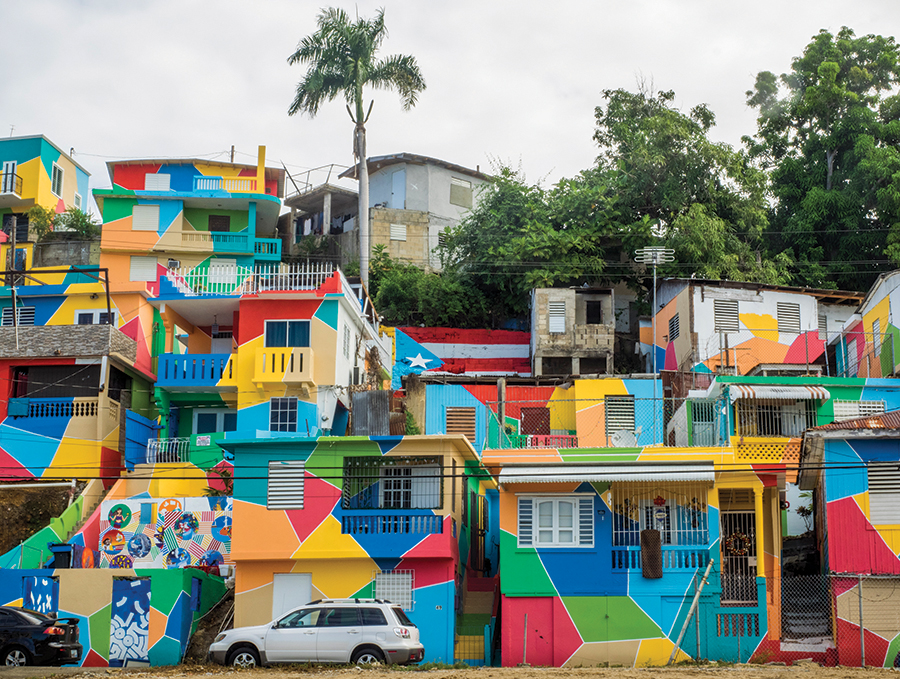
At night on Day Eight of the trip, during our rest day in La Parguera, we took a boat ride out to the bioluminescent bay. It was so dark, with stars shining bright in the sky, and as I dipped my body into the water, stars shone below too. I watched the stars follow my arms in the water and it was enchanting. I felt the stress of life wash off me in the dark and I hated to leave.
But I had to. We were on a journey.
One thing I enjoy most about long-distance cycling is the feeling of being in the zone. While in the saddle, I would check the rear mirror on my sunglasses, navigate turns, keep an eye out for people and cars, and sometimes we’d go a few miles without a word among us. We pedaled onward, on a mission, using our strength and two wheels to see the world. And we stopped for plenty of ice cream and coffee along the way, of course.
On a quiet rural road toward the end of Day Nine, the day we pedaled the 47 miles from La Parguera and Rincón, my body and mind were in a flow state. That day we had taken a longer stop to swim at a sunny beach in Cabo Rojo that Louis had recommended. The ocean had the clearest, most sparkling turquoise water I’d ever seen in my life, and although I had lamented that I would lose my momentum if we stopped for a swim, the spontaneous dip in the water was glorious and a boost to the soul. We took off our socks and sneakers and felt our toes in the soft sand. I turned to Saara and said, “If my worst complaint this week is ‘I have to go to the beach,’ then life is good.”
But time spent at the beach meant we had to hustle to the surfer town of Rincón before sundown at 6:30 pm.
As if in a collective trance, we rode silently past farms and a forested area about 10 miles away from our hotel that night. The group had split into thirds, and I was in the middle with Saara beside me and Louis just ahead. They both appeared hyperfocused, Saara with an intense expression on her face and Louis with the quicker speed of his pedaling. My mind wandered. You know when you’re taking a shower, disconnected from your phone or the demands of your job, and thoughts and ideas ease their way in? In a shower it’s just your body and the elements — air, water — in a way, it’s similar to when you are on your bike all day.
I wondered whether my three-year-old son was doing okay. Did he get enough veggies that day? Did he find nice kids to play with at day care? Was he sleeping well? Was he happy? Did he brush his teeth efficiently? How was my husband faring with the bedtime routine? Did they miss me?
A pang struck my heart as I peered out to the blue sky, so clear that evening, and I thought about how much I missed them. I missed holding my son’s little hand when we walked across the street and hearing him squeal in delight when I read stories aloud to him in funny voices.
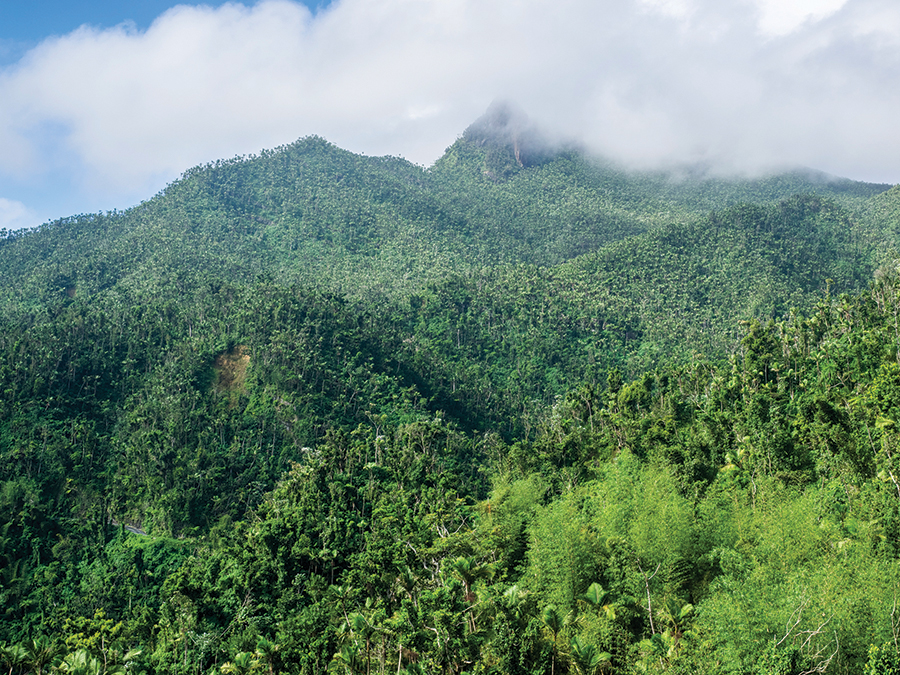
They say parenting is the most wonderful and terrible experience in the world, and it’s true. So while I missed my son as I pedaled, I also felt a sense of relief and happiness for my bicycling adventure, away from the stress of work and the “second shift” of parental duties. My son breastfed until he was two years old, but at age three he was still reaching for my breasts regularly for comfort. It was, to say the least, irritating. Here on the western coast of Puerto Rico, no one was touching me. For nine days now, my body was mine and no one else’s.
I pedaled faster past trees and saw the sun lower on the horizon as this thought dug its heels into my head. My body is mine. My body is mine.
For the first time in years, it really felt that way. My body was no longer someone else’s food source. My body was no longer growing a cancerous tumor in my ovaries. My body was not at the whims of a surgeon’s hands. My body was not under siege from endometriosis. My body was not stressed and tired in front of the TV by 9:00 pm. My body was not dizzy from work deadlines. My body did not feel back pain. My body was not sleep deprived from caring for a baby at odd hours in the night. And as heavy as I was from my weight gain, my body was cycling hundreds of miles around la isla del encanto, the island of enchantment, where coquí frogs croaked in the night and festive salsa music played in plazas everywhere.
My body had survived everything thrown its way. My body had more power than I ever gave it credit for. I slowed down as my vision blurred from unexpected tears, which I wiped away with the black (and badass) cyclist gloves I’d borrowed from Saara.
“You alright?” she asked.
I didn’t stop. I saw Louis up ahead and knew we needed to keep going.
“Just can’t believe I’m doing a bike tour,” I said, tears streaming down my face. “You know I’ve never been athletic. But I feel … ” I waved a hand in the air searching for the right word: “Empowered.”
She nodded and passed me a handkerchief from a small pouch attached to her bike.
“That’s what it’s all about, right?” she asked empathetically.
We only stayed a night in Rincón, where the outdoor lobby of the Villa Cofresí Hotel overlooked the ocean and a guitar player sang slow, relaxed tunes. I ordered a coco frio and watched the sunset before we gathered for dinner at the hotel restaurant.
A 66-year-old artist named Reinaldo Ruiz had a display of prints of his work outside the restaurant. One, called “La Bestia Maria,” depicted the hurricane on the beach, trees swaying violently. Another showed Puerto Ricans washing clothes in a river, which many people had resorted to doing after Hurricane Maria when the power was out for several months.
“I feel free in nature,” he told me. I understood.
Nearly 3,000 people died from the hurricane, according to Puerto Rican officials. Along our bike route around the island, a year and a half after Maria, we saw some homes and businesses in clear disrepair. Reinaldo spent five months without power in Aguada, a town east of Rincón, where he lived. He couldn’t get cash out of the ATM, didn’t sleep well, couldn’t contact relatives. His elderly mother, distressed and heartbroken, died weeks after Maria hit.
I bought a print from Reinaldo of a bike parked in a room with the door open, ready to leave and see the world. He told me he liked to have a window or door open in all of his work, to signify a sense of possibilities. I liked that thought.
We made it to San Juan on Day 12, our faces glowing from exercising in the rain, sun, and wind. We took victory photos on the ferry ride from Cataño to Old San Juan, then walked our bikes across the narrow cobblestone streets after leaving the pier. We celebrated with a seafood dinner and music that night. Afterward, Saara and I walked to a nearby plaza where a trio of guitar players sang, “Me voy, pero un día volveré a buscar mi querer, a soñar otra vez en mi viejo San Juan.” “I’m leaving, but one day I’ll return to find my love, to dream again in my old San Juan.”
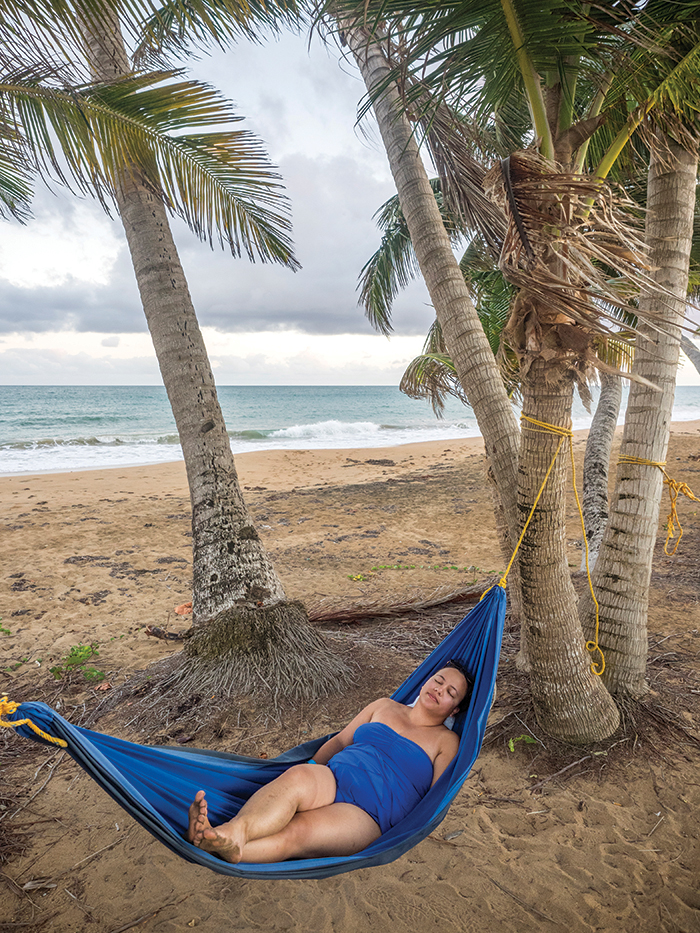
Nuts & Bolts: Puerto Rico
When to go
The best time of year to go is the winter when the weather is in the 80s and 90s. It’s a fantastic feeling to escape the cold and warm up on a sunny beach. Springtime in Puerto Rico is lovely too, and there are fewer tourists. The rainy season starts in May and extends through the summer months, but the rainfall isn’t as heavy as in other tropical locations. Hurricane season in Puerto Rico typically starts in August and ends in October so it’s best not to go during those months.
Where to stay
Even near tourist attractions like El Yunque National Forest and Old San Juan, hotels are very reasonably priced with nightly rates in the $80 to $130 range for three- and four-star hotels. We started and ended our Adventure Cycling tour at Hotel Milano, an unpretentious place in the heart of Old San Juan that was very accommodating of our bicycles. Rates are as low as $81 for a room with two double beds, and the location was walkable to bike paths, the ocean, two historic forts, shops, plazas, and nightlife. If you’re looking for something more eccentric with old architectural details, the Gallery Inn in Old San Juan is a few blocks away and has artistic rooms and suites overlooking the Atlantic Ocean. Attached is the Cannon Club, which includes a piano bar, lavish decor, an abundant art collection, and exotic birds.
Hotel Meliá, in the historic district of Ponce, is also a fantastic place to stay and friendly to bike travelers.
How to get there
The Luis Muñoz Marín International Airport in San Juan is the largest airport. Coming from the U.S. mainland, connecting flights from Atlanta, Georgia, or Miami, Florida, are common. There are also cruise lines that tour the Carribean and often dock at Old San Juan.
What to bring
Bring a waterproof phone mount. I downloaded the RideWithGPS app on my iPhone, which had routes for our group tour. If we got separated, it was very useful to find my way. I use AT&T, and there were no roaming charges in Puerto Rico.
Other tips
When cycling the loop around Puerto Rico, the terrain ranges from highways, residential roads, rural roads, a few gravel roads, hills, protected bike lanes, and sandy coastal trails.
If you hear rustling in nearby leaves or brush, it’s probably just a family of iguanas skittering away from you.
Go with Adventure Cycling
Adventure Cycling’s next Puerto Rico tour departure is in 2021. Keep an eye on our tours launch in late summer for dates and to sign up!

